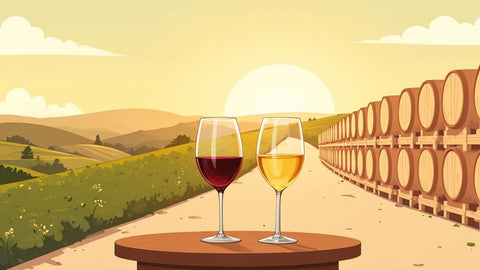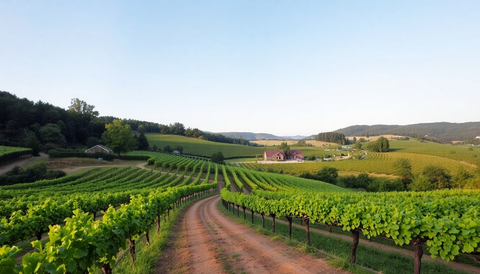Introduction
McLaren Vale stands among Australia’s most celebrated wine regions for Shiraz and Grenache. Distinct soils, coastal influences and a wide range of vine ages produce styles from bright, fragrant reds meant for early enjoyment to powerful, structured wines built for long cellar lives. This in-depth guide explains how to match McLaren Vale Shiraz and Grenache to the best cellaring and drinking windows, covering terroir, vintage variation, winemaking decisions, storage technique and food pairings. The goal is to help collectors and drinkers identify bottles that deliver at the right moment — whether that is tonight, in five years or in two decades.
McLaren Vale at a Glance: Climate, Soils and Vine Age
- Climate: Mediterranean with warm summers and cool coastal breezes. Diurnal temperature variation is important for retaining acidity and aromatic lift, especially in Grenache.
- Soils: A mosaic that includes terra rossa over limestone, red-brown earths, sandier pockets and deeper clay. Each soil type produces grapes with different concentration, tannin and acidity profiles.
- Vine age: Old vines (often 50+ years) are a hallmark of the region; they typically deliver lower yields, more concentrated fruit and more complex tannin structures.
How Terroir Shapes Ageing Potential
- Terra rossa over limestone: Often yields wines with fine-grained tannins, mineral lift and well-balanced acidity — favourable for medium to long-term cellaring.
- Red-brown earths and loam: Support concentrated Shiraz with generous fruit intensity and structure suitable for mid-term ageing.
- Sandy soils: Tend to produce lighter, fragrant Grenache that is approachable earlier but may lack the structure for extended cellaring unless vine age and viticultural practices add concentration.
- Coastal influence: Sea breezes moderate ripening, preserve acidity and create wines with balance that can age gracefully while retaining vibrancy.
Shiraz: Styles, Evolution and Cellaring Strategy
Shiraz from McLaren Vale covers a spectrum. Understanding the style on the label and from the vineyard source helps predict ageing. Below are typical styles, tasting evolution and recommended windows.
Shiraz Styles and Recommended Cellaring Windows
-
Bright, early-drinking Shiraz (light to medium-bodied)
- Profile: Fresh red and dark berries, peppery spice, moderate tannins and lively acidity.
- Cellaring: Best within 1–5 years of vintage.
- Why: Lower extraction and lighter oak encourage immediate enjoyment rather than long-term evolution.
-
Classic McLaren Vale Shiraz (medium to full-bodied)
- Profile: Black fruits, dark chocolate, savoury spice, medium to firm tannins and balanced oak integration.
- Cellaring: 5–12 years; standout examples 12–15 years.
- Evolution notes: Fruit concentration softens into plum, black cherry and complex spice. Tannins integrate and tertiary notes of leather and olive may emerge.
-
Reserve/High-extraction Shiraz (full-bodied, oak-rich)
- Profile: Intense dark fruit, dense tannin, evident new oak spice and long finish.
- Cellaring: 10–25+ years depending on vintage conditions and maturation style.
- Evolution notes: Primary fruit transitions to savoury, earthy and tertiary flavours such as tobacco, cured meat and dark chocolate.
Shiraz Tasting Evolution by Age
- Year 0–3: Bright primary fruit, floral lift on cooler vintages, youthful tannin. Ideal for drinking soon.
- Year 3–7: Fruit complexity increases; oak integrates; tannins round but retain structure. Great window for those seeking balance between freshness and complexity.
- Year 7–15: Transition to savoury and tertiary notes; the wine gains depth, leather and earthy characters with softened tannins.
- 15+ years: Older reserves show tertiary dominance — dried fruit, tobacco, game — provided storage conditions were optimal.
Grenache: Styles, Evolution and Cellaring Strategy
Grenache often expresses itself as fragrant, red-berry driven wine with supple tannins. Ageing ability varies widely depending on vine age, extraction and whether the wine is single-varietal or part of a GSM blend.
Grenache Styles and Recommended Cellaring Windows
-
Light, fragrant Grenache (youthful)
- Profile: Bright red fruits, floral notes, soft tannins and delicate structure.
- Cellaring: Best within 2–6 years.
- Why: Delicate aromatics are best enjoyed young before tertiary development masks freshness.
-
Structured single-varietal Grenache and GSM blends
- Profile: Layered red and dark fruit, spice from oak or blending partners, firmer tannins and more depth.
- Cellaring: 5–12 years; well-made examples 12–20 years.
- Evolution notes: Primary red fruit moves to berried compote, savoury spice and earthy notes; blends gain complexity from Shiraz and Mourvèdre influence.
-
Old-vine, low-yield Grenache
- Profile: Concentrated fruit, fine tannins, compelling mid-palate depth and longevity.
- Cellaring: 8–20 years depending on vintage and oak.
Grenache Tasting Evolution by Age
- Year 0–3: Perfumed florals, raspberry and strawberry, silky texture.
- Year 3–8: Fruit becomes richer; spice and savoury notes appear; tannins round.
- Year 8–15: Complex tertiary characters develop: earth, dried herbs, leather; colour softens from bright red to garnet.
- 15+ years: Deeply developed tertiary profile with savoury complexity — best for those who enjoy mature, nuanced wines.
Vintage Variation: How Year-to-Year Differences Affect Longevity
Not all vintages age the same. The following tendencies help predict ageing potential when assessing a bottle.
- Warm, dry vintages: Produce concentrated fruit and higher alcohol. These wines often have power for long-term cellaring but require careful balance of acid and tannin to avoid flabbiness over time.
- Cooler, moderate vintages: Yield wines with brighter acidity and refined tannins. Such wines often show excellent ageing balance and grace over the medium to long term.
- Vintage extremes: Very hot or very wet seasons can produce unpredictable results; selective vineyard sites and older vines tend to fare better for ageing.
Winemaking Choices That Influence Ageing
- Extraction level: Gentle extraction promotes earlier drinkability; higher extraction builds tannic structure for longer ageing.
- Oak regime: New oak imparts structure and spice that can support longevity. Seasoned or neutral oak preserves primary fruit and can create wines enjoyable earlier.
- Fermentation techniques: Whole-bunch fermentation and extended maceration can add spice, tannin texture and complexity that develop positively with time.
- Closures: Screwcaps preserve freshness and slow evolution; natural cork allows slow oxygen ingress, which can support development of tertiary characters in some wines.
Practical Cellaring: How to Store for Optimal Development
- Temperature: Maintain a steady 12C15C. Consistency is more important than hitting a precise number; avoid fluctuations that accelerate ageing and cause chemical reactions.
- Humidity: Keep relative humidity at 6075% to protect corks from drying and minimise the risk of oxidation in cork-sealed bottles.
- Light: Store in darkness or very low light. UV light degrades wine and dulls aromatic compounds.
- Vibration: Minimise vibration to prevent disturbance of sediment and slow undesirable chemical change.
- Position: Store bottles on their side if sealed with natural cork; upright storage is suitable for screwcaps and certain alternative closures.
- Security and access: Keep a clear inventory and plan for rotation; label boxes or racks with vintage and intended drinking window.
Closures and Long-Term Ageing Considerations
- Natural cork: Allows slow oxygen exchange that supports tertiary development; requires high humidity to avoid cork failure.
- Screwcap: Preserves primary fruit and acidity; wines under screwcap can age elegantly but follow a different evolution path than cork-sealed bottles.
- Technical corks and synthetics: Offer consistency and lower risk of cork taint; ageing trajectory varies with product design.
How to Build a Balanced McLaren Vale Cellar
- Define intentions: Decide on proportions for short-term drinking (15 years), medium-term (55 years) and long-term (10+ years).
- Allocate by vintage and style: Reserve more slots for structured Shiraz and old-vine Grenache from stronger vintages for long-term ageing.
- Quantity choices: Buy multiple bottles of significant releases to allow tasting at intervals without exhausting the stock.
- Record-keeping: Track purchase date, storage location and recommended drinking window. Schedule periodic tastings to evaluate evolution.
- Condition monitoring: Check storage conditions and bottle corks periodically, especially if stored for many years.
Buying Strategy: What to Look for on the Label and at Purchase
- Clear vineyard sourcing and statements about vine age highlight provenance and concentration potential.
- Maturation notes that explain oak type and time in barrel provide clues to ageing potential.
- Sustainable, organic or biodynamic certifications indicate stewardship of the vineyard and a commitment to long-term quality.
- Small-batch, single-vineyard or limited-release bottlings often present unique cellar candidates; balance rarity with accessibility and value.
- Retailer curation and provenance history help gauge authenticity and storage prior to purchase.
Food Pairings by Wine Age and Style
- Young, bright Shiraz (1 years): Chargrilled sausages, lamb skewers, tomato-based barbecue sauces, peppered beef.
- Classic Shiraz (52 years): Braised beef, slow-cooked ribs, mushroom ragout, semi-aged cheddar.
- Reserve Shiraz (10+ years): Rich game dishes, aged beef, dark chocolate desserts that can stand intense flavours.
- Young Grenache (2 years): Roast pork, light tomato pasta, charcuterie, herb-roasted vegetables.
- GSM and structured Grenache (52 years): Roast lamb shoulder, duck with orange glaze, spiced casseroles and dishes with preserved fruit.
- Old-vine Grenache (10+ years): Earthy mushroom dishes, braised venison, slow-roasted lamb and complex sauces that mirror tertiary notes.
Serving, Decanting and Glassware
- Serving temperature: Shiraz 1618C for lighter styles, 1719C for fuller reserves. Grenache 1416C for aromatic examples, 1517C for structured wines.
- Decanting: Young, tannic Shiraz benefits from 13 hours; reserve Shiraz may need longer or opening a day ahead. Fresh Grenache prefers minimal aeration; structured examples or older bottles benefit from gentle decanting to remove sediment.
- Glassware: Use medium to large-bowled glasses to concentrate aromatics and allow tasting of complex layers.
Reading a Bottle: Quick Decision Flow
- Check label for vineyard source, vine age and oak details.
- Assess vintage conditions: warm or cool? More concentration or higher acidity?
- Note closure type: cork usually signals potential for tertiary development, screwcap preserves primary notes.
- Decide based on style whether to drink now or cellar: light, fragrant wines for now; concentrated, structured wines for cellaring.
Common Questions and Practical Answers
- Is older always better? Not necessarily. Ageing enhances structure and tertiary complexity for certain styles but can diminish the floral and fresh fruit characters prized in lighter Grenache. Choose based on style and personal preference.
- How many bottles should a beginning cellar hold? Start small: 120 bottles across a mix of short, medium and long-term styles provides variety and learning opportunities without large commitment.
- Can screwcapped wines age? Yes. Screwcap seals preserve freshness and can allow graceful ageing along a different trajectory from cork-sealed wines.
- How to tell when a bottle is at its peak? Keep tasting notes and revisit at intervals. Peak windows differ by style; track development from youthful fruit through integration to tertiary complexity.
Aligning Selection with Core Values
Choose wines that reflect authenticity of site and production. Prioritise curated selections from reputable retailers that provide provenance and sustainability information. Look for limited releases and old-vine examples to add exclusivity while keeping accessibility in mind. Focus on wines that demonstrate stewardship of the land and clear vineyard sourcing to ensure long-term value and meaningful discovery.
Final Thoughts
Matching McLaren Vale Shiraz and Grenache to the right drinking windows combines knowledge of terroir, vintage, style and storage practice. From immediate drinking pleasures to long-term cellar projects, the region delivers options for every palate and purpose. With deliberate selection, careful cellaring and a tasting plan, each bottle can reveal a rewarding progression — celebrating the region’s authenticity, curated quality and commitment to sustainable stewardship. Savour the journey from soil to shelf, and let each opening be an opportunity for discovery and enjoyment.




Comments (0)
There are no comments for this article. Be the first one to leave a message!